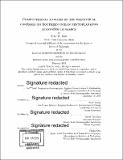Computational analysis of the biophysical controls on Southern Ocean phytoplankton ecosystem dynamics
Author(s)
Rohr, Tyler W.
Download1102055489-MIT.pdf (30.91Mb)
Other Contributors
Joint Program in Oceanography/Applied Ocean Science and Engineering.
Massachusetts Institute of Technology. Department of Earth, Atmospheric, and Planetary Sciences.
Woods Hole Oceanographic Institution.
Advisor
Scott Doney and David Nicholson.
Terms of use
Metadata
Show full item recordAbstract
Southern Ocean net community productivity plays an out sized role in regulating global biogeochemical cycling and climate dynamics. The structure of spatial-temporal variability in phytoplankton ecosystem dynamics is largely governed by physical processes but a variety of competing pathways complicate our understanding of how exactly they drive net population growth. Here, I leverage two coupled, 3-dimensional, global, numerical simulations in conjunction with remote sensing data and past observations, to improve our mechanistic understanding of how physical processes drive biology in the Southern Ocean. In Chapter 2, I show how different mechanistic pathways can control population dynamics from the bottom-up (via light, nutrients), as well as the top-down (via grazing pressure). In Chapters 3 and 4, I employ a higher resolution, eddy resolving, integration to explicitly track and examine closed eddy structures and address how they modify biomass at the mesoscale. Chapter 3 considers how simulated eddies drive bottom-up controls on phytoplankton growth and finds that division rates are, on average, amplified in anticyclones and suppressed in cyclones. Anomalous division rates are predominately fueled by an anomalous vertical iron flux driven by eddy-induced Ekman Pumping. Chapter 4 goes on to describe how anomalous division rates combine with anomalous loss rates to drive anomalous net population growth. Biological rate-based mechanisms are then compared to the potential for anomalies to evolve strictly via physical transport (i.e. dilution, stirring, advection). All together, I identify and describe dramatic regional and seasonal variability in when, where, and how different mechanisms drive phytoplankton growth throughout the Southern Ocean. Better understanding this variability has broad implications to our understanding of how oceanic biogeochemisty will respond to, and likely feedback into, a changing climate. Specifically, the uncertainty associated with this variability should temper recent proposals to artificially stimulate net primary production and the biological pump via iron fertilization. In Chapter 5 I argue that Southern Ocean Iron Fertilization fails to meet the basic tenets required for adoption into any regulatory market based framework.
Description
Thesis: Ph. D., Joint Program in Oceanography/Applied Ocean Science and Engineering (Massachusetts Institute of Technology, Department of Earth, Atmospheric, and Planetary Sciences; and the Woods Hole Oceanographic Institution), 2019 Cataloged from PDF version of thesis. Includes bibliographical references (pages 193-220).
Date issued
2019Department
Joint Program in Oceanography/Applied Ocean Science and Engineering; Massachusetts Institute of Technology. Department of Earth, Atmospheric, and Planetary Sciences; Woods Hole Oceanographic InstitutionPublisher
Massachusetts Institute of Technology
Keywords
Joint Program in Oceanography/Applied Ocean Science and Engineering., Earth, Atmospheric, and Planetary Sciences., Woods Hole Oceanographic Institution.